Reading List
The most recent articles from a list of feeds I subscribe to.
The Blood Of Dawnwalker Is More Than The Witcher With Vampires

Admittedly, from what I've seen of newcomer developer Rebel Wolves' upcoming first game, The Blood of Dawnwalker, it's given off some heavy Witcher vibes. That's not completely misplaced, considering Rebel Wolves was formed by former CD Projekt Red devs with experience working on The Witcher series and Cyberpunk 2077. Sure, there are vampires, but it's still a medieval dark fantasy where the protagonist is a gruff swordsman with one goal in mind.
After an hour-long hands-off preview with Dawnwalker, though, it's clear this game is much more than just The Witcher with vampires. Sitting in the room, themed to look like a 14th-century chapel, I frantically took notes of what I was watching on screen, wishing the entire time I was the one playing the game.
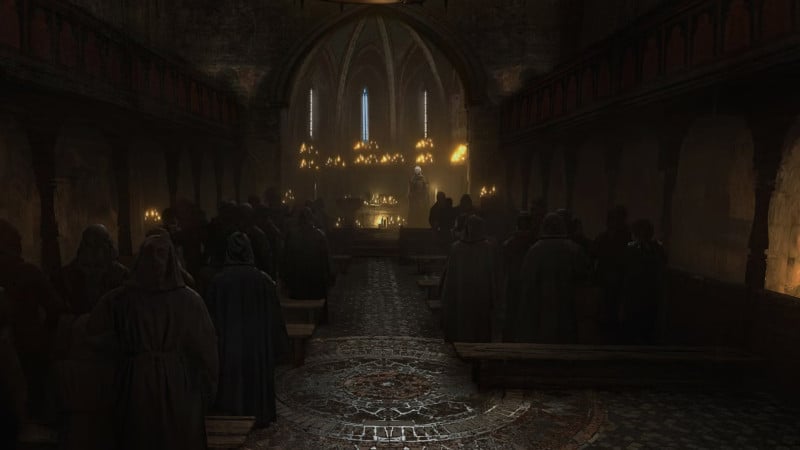
The demo begins in the valley of the Carpathian mountains, sometime during the 14th century. A plague has swept the land, weakening humanity, making them easier than ever to be overtaken by the Vrakhiri, or a race of vampires. Our protagonist, Coen, is what's called a Daywalker, and though details on what that entails are still murky after my preview, it's clear he is at least part vampire.
Rebel Wolves showcased this by running us through the same quest twice: once during the night, when Coen is tapped into his vampire side, and once during the day, when he can't use his vampiric abilities but can utilize magic. Though this quest ended on the same note both ways, there was an impressive amount of variation between the day and night versions.
Rebel Wolves began with the nighttime version of the quest.
Immediately, I'm impressed with the visuals. Sure, the game has been Epic's baby for demonstrating Unreal Engine 5 in recent showcases, but the art team is doing some gorgeous work with lighting. The way the full moon above illuminates the central cathedral's stained glass reminded me of the stained glass I witnessed myself at the Dom cathedral here in Cologne. Alongside the full moon high above in the sky is a red full moon, indicating Coen can tap into his vampire abilities.
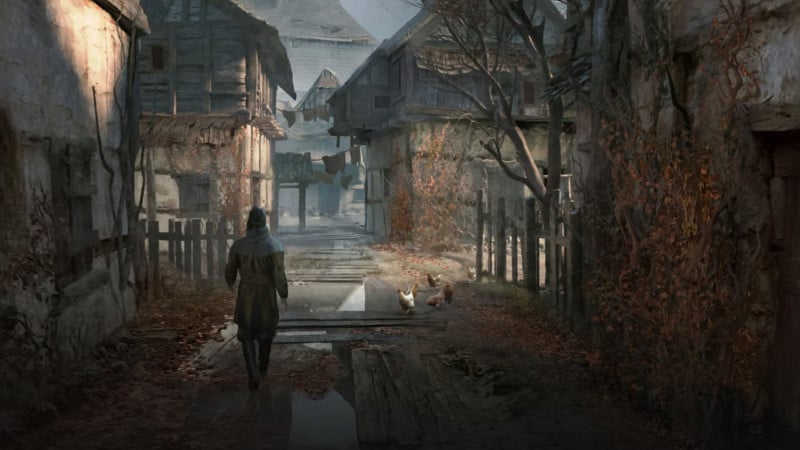
Coen infiltrates a cathedral and sticks to the upper floors as, down below, a blood ritual is happening. He uses Plane Shift to walk on walls and ceilings like Spider-Man, albeit on two feet. He also utilizes Shadowstep, which allows him to teleport short distances by transforming into a moving shadow. In the cathedral, he searches nearby Frescoes painted on the ceiling, looking for a clue as to the whereabouts of St. Mihia's crypt, which houses a sword he's after.
After a bit more exploration, Coen fights off some enemies using his claws. It's fast, visceral, and extremely gory, with dismemberment galore. He also uses Voracious Bite to suck their blood and regain some health. Rebel Wolves says this is useful in battle but even more effective outside of combat. Rebel Wolves also uses this encounter to show off the options to switch between a far and close camera in combat (and a separate option to customize this viewpoint in exploration, too).
We eventually reach the crypt, and this portion of the demo ends.
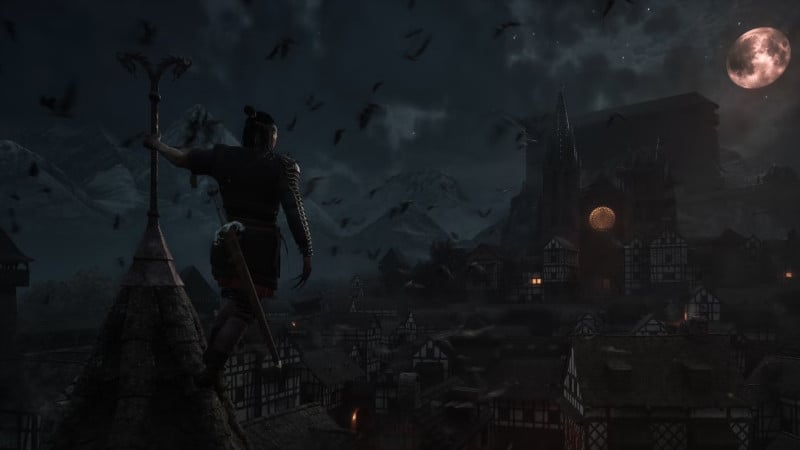
In the daytime version of the quest, Coen is unable to tap into his vampiric abilities, so he must investigate things more closely. To keep it somewhat spoiler-free, instead of climbing walls and ceilings and Shadowstepping to different platforms, Coen speaks with a local monk and agrees to help them find a missing person. This leads him to an abandoned portion of an asylum, and it turns out the person he's after has become The Almshouse Monstrosity. This person is neither undead nor alive, stuck in the transition from human to vampire, and their mind is essentially gone, driven by an instinctual desire for blood.
In this form of combat, Coen uses a sword instead of claws, and it's here that the game looks most like The Witcher. However, Rebel Wolves is doing some interesting things here. Combat features directional blocking, like what's seen in the Kingdom Come: Deliverance series, and magic, too. After defeating this monstrosity, Coen uses the Compel Soul hex to speak with a corpse and learn what happened in this asylum. This corpse yields some useful information that eventually takes Coen to the same crypt from the conclusion of the nighttime demo, except this time, Rebel Wolves showcases what happens next. I won't spoil it here, but it's an awesome boss fight against an undead warrior, and it's clear you'll need to tap into all of Coen's abilities to come out victorious.

Our demo ended here, and a day later, I'm voracious for more. It just looks awesome, and a great score heightens the entire experience. Like The Witcher, the score in Dawnwalker relies heavily on a high-pitched female chorus, and it rules. I can't wait to hear more of this and see more of the vampires that run this part of the world when The Blood of the Dawnwalker launches sometime next year.
Keeper Is A Salvador Dali-Inspired Surrealist Adventure With No Dialogue, No Combat, And A Walking Lighthouse
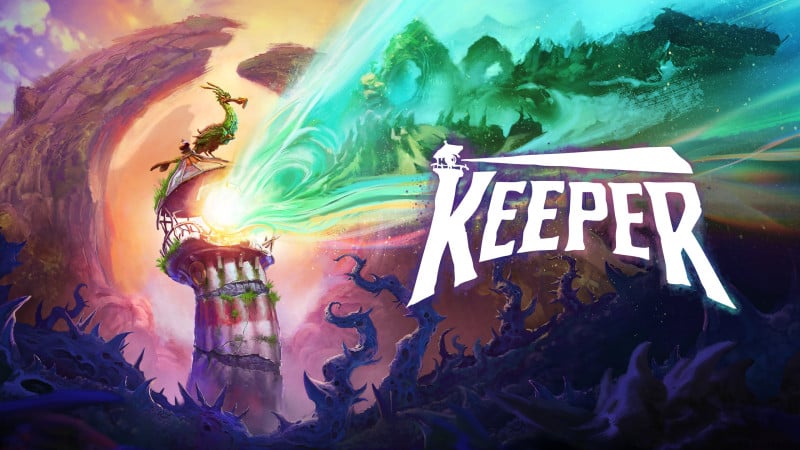
It's not often I'm thrown when previewing a video game. But thrown is exactly what I was when I stepped into the unassuming Xbox Room #10 in Xbox's business hall booth during Day 1 of Gamescom 2025. There were six seats, a small table, and a television showcasing Keeper, the upcoming adventure game from Psychonauts developer Double Fine Productions centered around a walking lighthouse and a bird. Oh, and the studio's CEO and games industry legend, Tim Schafer.
Nobody told me the person showcasing Keeper would be Schafer, and it's kinda wild to walk into a room and be surprise-greeted by a developer you massively respect. Of course, Schafer is a true gentleman, kind, and genuinely hilarious, so the nerves quickly disappear as he walks me through three previously recorded gameplay segments of Keeper.
I promise I'll talk about those segments, but everything Schafer told me beforehand was just as interesting (possibly more). First off, it's his first time doing press since 2021 with Psychonauts 2, so Schafer explains that he's nervous – ahhh, even ground – and his first time at Gamescom in 16 years! Though he was here in person to talk about Keeper, he mostly speaks about Lee Petty, the game's director (and Brutal Legend and Broken Age art director) and the person behind the wild idea that is Keeper.
Schafer says Keeper wouldn't exist without Double Fine becoming an Xbox studio. "Around the time we had just joined the Xbox family, we were wondering what we should make next," Schafer says. "We have support; we have money; and we don't have to worry about going out of business every day, and we don't have to pitch to publishers, 'Please make our game, it's very commercial.'"
At the same time, Petty was busy thinking about his time during the peak of the COVID-19 pandemic. He was locked in his home like the rest of us, but he found solace in nature hikes amongst the hills around San Francisco. He couldn't get an idea out of his head: what if humanity didn't survive this, but nature did and took over in our place? It's here that Schafer explains Petty is a "weird dude who loves strange images, and grew up loving Dark Crystal and Salvador Dali."
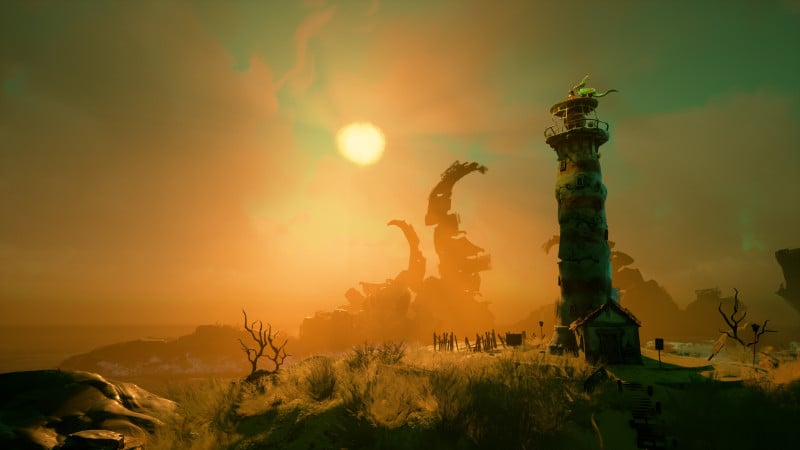
The result of all that pondering is Keeper – weird and chill, like Petty and his interests, Schafer says. He then describes the game as an adventure game with puzzles – light puzzles, though, because Keeper is about the "atmosphere and vibes and companionship between these two." The two he's talking about are Twig, a sea bird, and an unnamed lighthouse. After a violent sea storm isolates Twig from her flock, she perches on a lighthouse. For some reason, this awakens the lighthouse, it tips over, and in the resulting crash, it grows legs. Typical lighthouse behavior.
Awakened and the new owner of legs, this lighthouse feels immediately called to a giant mountain peak atop the island it's on. So, it begins heading that way, with Twig in tow. Controlling the lighthouse consists of moving through surrealist and fantastical landscapes and shining your beam on things. You can shine your beam on plants and sometimes they'll grow; you can shine your beam on gears and sometimes Twig will fly to them and rotate them to unlock gates; you can shine your beam on strange pot creatures that crash to the floor beneath them, sometimes revealing objects for Twig to interact with.

Your primary method of interacting with this world is your beam, and second to that is Twig. This might just be a me thing as someone who lives a couple hours away from Disney World and has a fondness for the technology of animatronics, but Keeper most reminds me of a Disney dark ride. If you're unfamiliar with that term, dark rides include Pirates of the Caribbean and The Haunted Mansion. It's less about thrills and more about experiencing the things around you, watching animatronics move to tell a story, and soaking in the vibes. That's Keeper.
I love that shining your light on objects causes them to emote or come to life with animation. It might not affect your journey forward or be part of a puzzle every time, but that's okay – it's about the vibes! It's about watching the animatronics of this world, as it were, do things that make the surrounding area feel real, like it has its own story to tell.
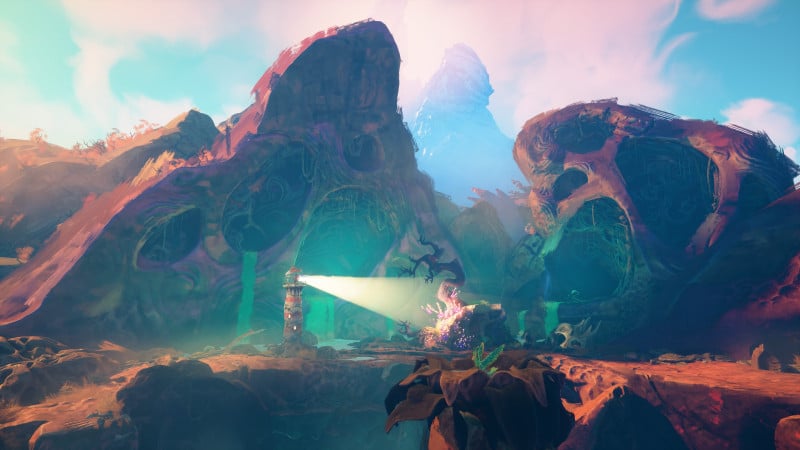
The puzzles I see seem simple and quick, but I can't help keeping an eye on the things outside the primary focus of these gameplay videos. I see sunflowers dance as light grazes over them, carrots come to life and dive bomb into the soil below, and more. It really feels like a Double Fine dark ride in the most complimentary way.
Of course, I see some other things that catch my eye. At one point, Twig becomes a giant egg atop the lighthouse for some reason. I see a village of tiny lil guys that are rusty watches. I see the lighthouse prance through pink pollen that gives it a light, low-gravity effect when it jumps. Everything I see looks vastly different from what I witness moments before, but it's all oozing with Double Fine and surrealist Salvador Dali-inspired charm.
Some areas are more linear, designed around puzzles, Schafer says. Other areas are more open, prime for exploration. Regardless of where you are in the lighthouse's journey to the mountain peak, Schafer says Keeper is ultimately about change; how nature changes, how Twig changes, how the lighthouse changes. Every character, including Twig and the Lighthouse, has a story arc, he adds.
When I ask Schafer why Petty decided to have players control a lighthouse, Schafer laughs – he doesn't actually know. He says the lighthouse was one of the game's side characters, but when he saw it walking with legs, he told Petty that needs to be the game. "It was compelling," Schafer says. "It really looked like something from a surrealist painting."

Schafer ends my presentation further explaining Double Fine's love of nonsense and the bizarre, the type of work directors David Lynch and David Cronenberg are interested in making, he says. I see the vision.
Keeper is a weird game, but it has that undeniable Double Fine charm. I can't wait to actually play it when it launches on October 17 on Xbox Series X/S and PC.
There Are No Ghosts at the Grand Preview - Renovating A Haunted Hotel Isn't Easy, But It Is Quite Musical

Platform:
Xbox Series X/S, PC
Publisher:
Friday Sundae
Developer:
Friday Sundae
The pitch for There Are No Ghosts at the Grand might seem like word salad: mystery, renovation, exploration, horror, musical, and more. It's a strange mix of gameplay and vibes that does, somehow, blend together just right for a tune that can get your toe tapping.
"You know, we didn't start off with the intention of writing a musical," writer and creative director Anil Glendinning says. "We wanted to write a ghost story. We wanted to write a ghost story set in Britain that kind of sent shivers up your spine and reminded us of TV shows that we watched when we were kids."
This is the strange concoction that we learned about in an online, hands-off preview from developer Friday Sundae about There Are No Ghosts at the Grand. It started simple enough, with your protagonist Chris David, an American who's inherited the crumbling Grand in a seaside British village, tasked with tidying up the lodge.
 Friday Sundae
Friday Sundae
A magical renovation machine, somewhere between a power-washer and sci-fi arm cannon, gives you the do-it-all potential to repaint, de-clutter, vacuum, and re-arrange furniture. The tools seem simple to use, but allow for some player expression in paint choice, decor positioning, and more. It feels like an easy sell to house-flipping fans.
But a cell phone call from Mayor Greene, on a wonderfully dated brick of a phone, draws David out and onto a moped. She wants to investigate a nearby island to see if it's where all the mysterious black goo that's been troubling the town is emanating from; and after fixing up a boat to take you there, would also like to sing to you about why you should give back your inherited hotel rather than keep it for yourself.
There Are No Ghosts at the Grand is a musical, yes. But rather than showtunes or Gilbert & Sullivan, it draws on other veins of UK influence: ska, punk, and reggae. Glendinning name-checks bands like The Specials, The Clash, Madness, and The Selector in our chat. These influences run parallel to the broader vibe of small, seaside British town horror, too, with splashes of Doctor Who in there for good measure.
During the musical number, in which Mayor Greene sings her side set to a catchy guitar riff and beat reminiscent of your '80s ska vinyls, the player gets a chance to (musically) respond in kind, which can affect your relationship with Greene depending on your answer. The immediate ramifications are not clear, but this choice, alongside optional renovation projects and exploration the player can undertake in the town, makes me curious to see if there are winding, maybe even branching, paths to explore.
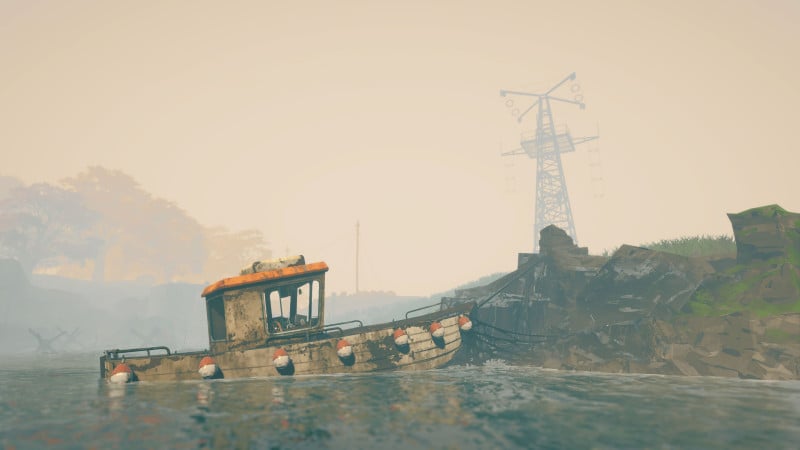 Friday Sundae
Friday Sundae
For now, the boat and song get abruptly interrupted by a crash. And while your handy-dandy sci-fi fixer-upper cannon can fix the boat and remove the goo holding it in place, it sends both the boat and Greene out to sea in the process.
A search for shelter for the night leads to an abandoned World War II bunker and all kinds of ambient scares, but also some mystery and puzzle-solving. The environmental puzzles we see in the demo are, according to Glendinning, toned down in challenge for the Gamescom demo, but the final game will feature more difficult mysteries to solve and information to uncover.
These mysteries and puzzles also arrive in the form of memories. Renovations can be undertaken outside the Grand, too, and alongside making yourself a nice little bedroom inside the bunker, you can also use the tool to reform an area and trigger ghostly flashbacks of the past, hinting at the secret history of this seaside town.
 Friday Sundae
Friday Sundae
An escape from the bunker leads to a surreal chase scene with creepy, crawly chair monsters in a delightfully tense finale. There are other bizarre mysteries to touch upon – a talking cat, a listening station picking up disturbing signals, maybe even ghosts – but all of those are better left for the final game.
There Are No Ghosts at the Grand already has a killer combination of ideas and themes. But after seeing it in action, I'm most impressed by how well all those parts work in concert; simple and effective renovation tools, catchy musical motifs, dialogue choices, and a creepy atmosphere all make this strange and exciting premise come to life. Friday Sundae's hotel renovation horror musical seems like it could be a hot ticket when it arrives in 2026.
Sony Is Raising The Price Of Every PlayStation 5 Model Tomorrow, August 21

Rising video game and console prices have frustrated consumers this year, and today, Sony is adding its flagship console to the list of products getting price hikes. In the United States, the PS5, PS5 Digital Edition, and PS5 Pro are each increasing in price by $50.
According to a blog post from Sony Interactive Entertainment vice president of global marketing, Isabelle Tomatis, the change is due to "a challenging economic environment." This brings the new prices for each device to the following:
- PlayStation 5 – $549.99
- PlayStation 5 Digital Edition – $499.99
- PlayStation 5 Pro – $749.99
As of today, prices remain unchanged in other countries, but many of them faced price hikes earlier this year. This news comes a few months after Sony said it was considering raising its prices in the US, but it might not affect consoles. That was, obviously, not the case. Other instances of companies increasing prices lately include Nintendo increasing Switch 2 accessory prices, and Xbox raising its console and game prices back in May. Across the board, it's a rough time to be paying for new games and hardware.
Meanwhile, Xbox announced its new handheld's release date today, but won't reveal its price quite yet, citing "macro-economic conditions."
Xbox Reveals ROG Xbox Ally X Handheld Release Date But Not Price, Due To 'Macro-Economic Conditions'

We're officially in the Gamescom cycle, which means a steady stream of previews, like our hands-on impressions of Hollow Knight: Silksong, and news tidbits. Xbox provided the latter today, announcing that its upcoming handheld line, the ROG Xbox Ally and Ally X, will hit store shelves on October 16, just two months from now.
However, while the release date is clear, we don't yet know how much either product will cost. In a roundtable interview with IGN, Asus senior vice president Shawn Yen said, "I think we will have to... we need more time to figure the macro-economic impact to pricing, and that's why we'll be sharing more later, in September and October." Because the prices aren't yet live, neither are pre-orders.

The handheld is made in partnership with Asus, a company that has been producing the ROG Ally handheld for a few years now. The cheaper models currently retail for around $500 USD, so it's likely that a partnership between Asus and Xbox would go for around that amount or higher.
Xbox's release date announcement also detailed some of the handheld's new features, including a handheld compatibility program, which helps to indicate which games are best suited for handheld play, similar to the Steam Deck's verification program. On Xbox, games will either be "Handheld Optimized" or "Mostly Compatible," with the latter requiring "minor in-game setting changes for an optimal experience on handheld." There's also a "Windows Performance Fit" rating to judge how well the game will run on your device.
Stay tuned to our Game Informer coverage to see our hands-on impressions with these devices. In the mean time, catch up on the coolest games we've played at Gamescom 2025, which we'll be updating as the week continues.